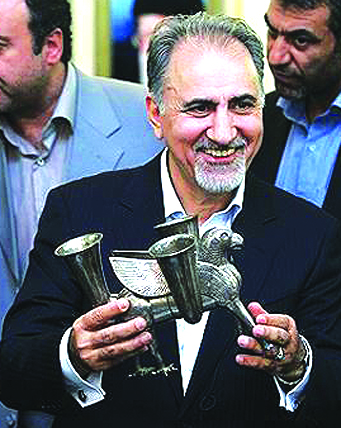November 01-2013

Questions have been raised about the 2,700-year-old drinking cup returned to Iran by the United States with some experts in the field saying it is a fake.
The piece, a silver chalice in the shape of a winged griffin, was thought to have originated from the Kalmakarra cave in western Iran and been stolen.
US Customs officials seized the artifact from a Lebanese-American antiquities dealer who was attempting to smuggle it into the United States in 2000. The griffin sat in storage in a New York warehouse for more than a decade until President Rohani’s trip to the United Nations in September, when the United States handed it over. (See Iran Times of October 4, page one.)
But Hamid Baqai, former head of the Iranian Cultural Heritage and Tourism Organization, says the artifact is without question a modern forgery. “Firstly, the way it has been made and the style in which it has been made shows it’s a fake. This artifact doesn’t have any roots in ancient Iran,” Baqai said. “Secondly, from a technical point of view the materials used to make it also show that it’s not an original.”
Baqai was an Ahmadi-nejad appointee and can be said to have political motivations to embarrass the new administration over its enthusiastic reception of the drinking vessel.
But questions about the artifact aren’t just raised by Rohani’s opponents.
American archeologist Oscar White Muscarella, a former curator of the Metropolitan Museum of Art in New York, says he, too, believes the artifact is a fake. He wrote in a paper published last year in which he said it took only a glance at a photograph to convince him it was a fake.
“It is a modern Iranian artifact,” he wrote in the paper published by SAFE/Saving Antiquities For Everyone. “For stylistic and technical reasons — the griffin’s head is frozen mute, its eyes stare, the head, wing, and leg patterns are awkward and meaningless, and the leg rivets are modern: all attributes unlike any ancient conception — I condemned it as a forgery.”
Muscarella, 82, who excavated in Iran in the 1960s, estimated that the artifact was not more than 14 years old. But he had not seen or handled the actual artifact and was speaking based on photos.
Muscarella has gained considerable notoriety in his efforts to unmask many artifacts as forgeries. His book The Lie became Great. The Forgery of Ancient Near Eastern Cultures (2000) was a blistering attack, which included a long catalogue of specific objects in museums, private collections, and the art market that he said were modern forgeries.
Baqai also says the black market is full of hundreds of forgeries of ancient Iranian artifacts, some of which make their way to art collections and museums in the West.
He suggests that the US government must have known the artifact was fake, thus adding another political element to his criticism. The US government has not said anything about the dispute.
Mohammad Ali Najafi, the new head of the Cultural Heritage Organization, unveiled the artifact September 28 at Tehran’s Mehrabad Airport after returning with Rohani from New York.
The Iranian government has yet to publicly issue a statement regarding the authenticity of the artifact.
The ancient vessel is thought to be part of the Western Cave Treasure, a hoard of ancient silver that was found in a cave near the Iran-Iraq border in the late 1980s. Soon afterward, looters plundered the site, which was poorly protected, and some of those treasures found their way to the international antiquities market.
US authorities say New York antiquities dealer Hicham Aboutaam brought the pre-Achaemenid artifact into the United States in 2000, and provided Customs officials with an invoice falsely claiming the piece came from Syria. Aboutaam negotiated a deal to sell the artifact to a collector for $950,000 — but, when federal agents caught wind of the sale of an Iranian artifact, they seized it and arrested Aboutaam on smuggling charges in 2003.
In 2004, Aboutaam pleaded guilty to a misdemeanor charge in connection with the false import claim and paid a $5,000 fine.
The artwork has been dated to the era of the Medes. In 612 BCE, the Medes rose up and, with foreign help, captured Nineveh and caused the collapse of the Neo-Assyrian Empire that had ruled the region for three centuries.
The rhyton is in the shape of a griffin with three drinking cups attached.
The griffin is a legendary creature with the body, tail and back legs of a lion; the head and wings of an eagle; and eagles’ talons as its front feet. As the lion was traditionally considered the king of beasts and the eagle was the king of birds, the griffin was thought to be an especially powerful and majestic creature. The griffin (shir dal in Farsi) was thought of as the king of all creatures. Griffins are known for guarding treasure and priceless possessions.